How To Stop A Dog From Chewing
To stop a dog from chewing you need to understand what is motivating them. Although mouthing and gnawing is normal, especially in Labradors, it can last for much longer than early puppyhood teething. Destructive chewing is best avoided by reducing boredom, treating any anxiety problems, providing appropriate toys, and preventing very young dogs from having access to your more precious or fragile things.
With dogs that have already become destructive, it is especially important to break the habit by preventing access to the things he destroys. This can take a little time and patience, but gets long term results.
*The products linked in this article were carefully selected by me to be shared on The Labrador Site. If you decide to purchase using the links provided, you’ll be supporting our site by allowing us to earn a small commission on that sale. This is at no extra cost to you.
Appetite For Destruction
The first thing to say is that I feel your pain! Most dog owners face this at some point and it can be very distressing. Chewing is very destructive and even small puppies can do a lot of damage with their little teeth. It is no joke to find valuable possessions in tatters, or your home looking like the aftermath of a termite invasion. But, before we can tackle a problem like this and stop dog chewing, it is helpful to talk about what is normal and what is not. We need to use a bit of animal psychology and establish the root causes of both normal and abnormal chewing.
Why Do Dogs Chew?
Most people realize that the desire to chew is a normal stage of puppy development. Owners usually expect teething puppies to chew to some extent, but the sheer scale of the destruction can surprise people! Naturally, many owners buy expensive toys and chews, expecting puppies to chew on their own things instead of the humans’ possessions! Sadly, some puppies ignore these and prefer to chew dad’s shoes and mom’s clothes. I’ve even had a puppy take money from my handbag and chew that to small pieces!
Some dogs definitely chew much more than others do. And, while we assume they will grow out of it, destructive chewing can persist in some dogs long past the puppy teething stage. Dog chewing is more common in some breeds than in others. In fact Labradors are particularly prone to being persistent chewers.
The Reasons For Dog Chewing
While many owners assume that puppy chewing is because of teething, dogs chew for a whole bunch of different reasons, including:
- Teething
- Retrieving Instincts
- Boredom
- Anxiety and stress
- Relaxation
- Habit
We’ll look at each of these in turn, after we look at why dogs chew things. If your dog chews everything, is your Labrador suffering from some kind of behavioral problem? Is dog chewing normal? Let’s find out!
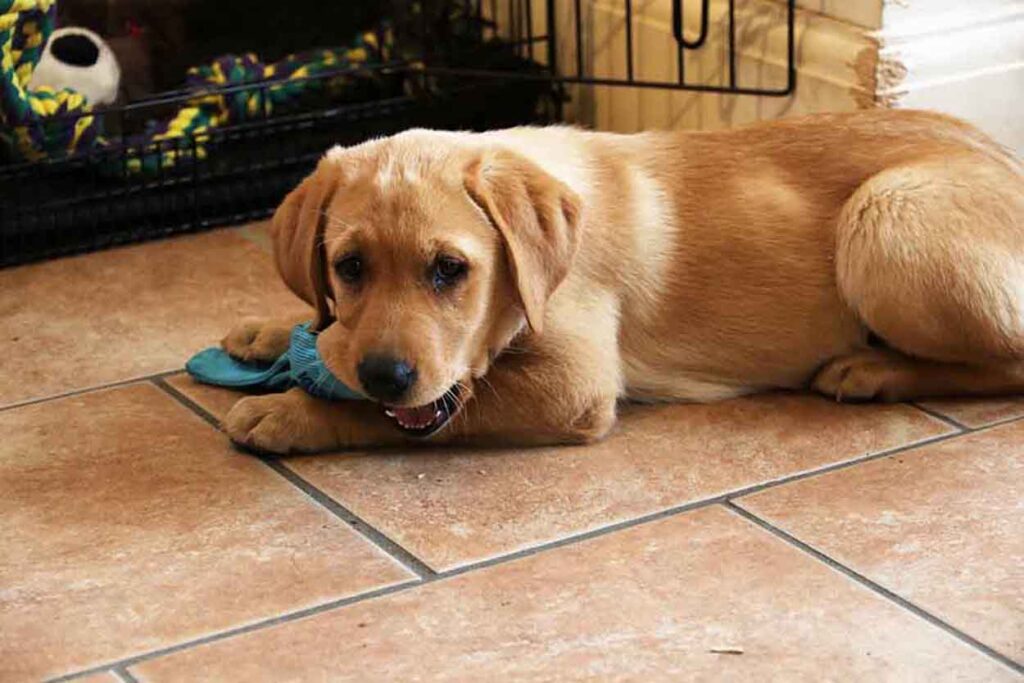
Is Chewing Normal?
Just take a visit to our forums and you will see some of the debate going on about dog chewing. For example, I have read some interesting threads on forums, usually started by frustrated owners of puppies around six months of age that are systematically destroying the family’s possessions.
The responses vary and different dog owners have completely different opinions, often shaped by their own experiences. Some believe that this behavior is abnormal, claiming that “none of my dogs ever did that.” Others think that dog chewing is completely normal.
Over the last thirty-five years I have had usually had five or more dogs living with me at any one time. And, I have raised many puppies, so I have learned about destructive chewing the hard way. In the early days I had countless chair legs ruined, entire vehicle safety belts devoured, baseboards eaten, and numerous other items scoffed, chomped, or otherwise disassembled! I know from experience that it can be very distressing even for the most passionate dog lovers.
I have learned from these experiences, though perhaps not quite as quickly as I should have! In addition, I discovered many ways to avoid serious damage to our home and possessions when a new puppy joins our family. I’ll share those with you in a moment.
Dog Chewing And Age
My main point here is that dog chewing behavior, including extremely destructive chewing, is very common, and it is perfectly normal. That doesn’t mean that all dogs chew, but some certainly do. Over the years, I found that it is particularly common in young Labradors up to a certain age. In older dogs however, chewing can be a sign that things are not quite right in your dog’s life. Perhaps you need to make a few adjustments to his routine or schedule. Of course, when I say it’s common up to a certain age, what age do I mean?
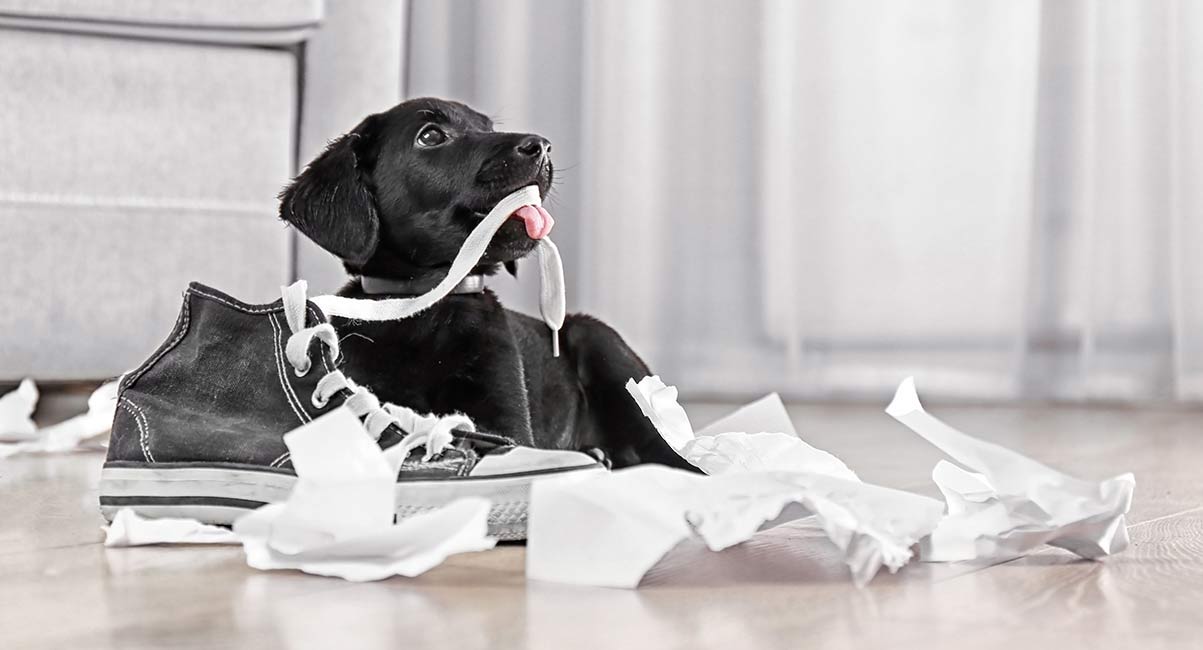
How Long Does The Chewing Stage Last?
Many people assume that chewing is to do with teething. Accordingly, they naturally expect puppies to stop chewing everything in sight once they lose their baby teeth and their adult teeth emerge. For many dogs, that is perfectly true. It’s all due to teething and most will grow out of it. However, for many Labradors, chewing continues long after the puppy has his full set of adult teeth
In fact, it is normal for a Labrador to continue chewing destructively up until around his second birthday. Chewing tends to fall off quite dramatically after that in dogs with sufficient company and mental stimulation. So, if dog chewing isn’t always down to puppy teething, what other reasons are there? Let’s look at some of those ’causes’ of chewing in a bit more detail. We’ll start with teething before looking at a few other reasons.
#1 The Puppy Chewing Stage
Your puppy will have cut his first teeth long before he joins your family. The teething process you will go through together involves shedding the baby teeth he arrived with and ending up with a full set of big dog teeth. His puppy teeth will start to loosen at around four months old, and he’ll have all his adult teeth by around seven months of age.
But, for many Labs, the teething stage is just the beginning. Part of that lies in the origins of your Labrador’s role as a retriever. Of course, many working dogs bred for retrieving share this tendency to chew things because it is often hardwired into them.
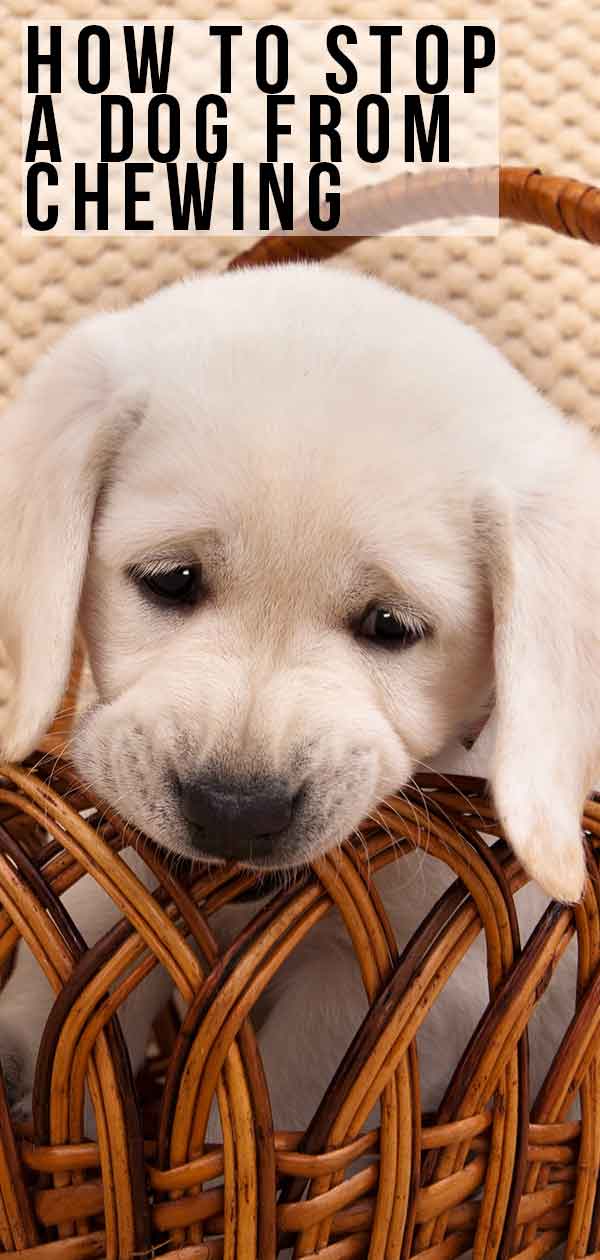
#2 Retrieving Instincts And Mouthiness
Dogs bred for many generations to work as retrievers for their human hunting companions are often what we refer to as ‘mouthy.’ Over the generations, breeders selected dogs that would retrieve game without damaging it. Accordingly, they are highly ‘mouth’ orientated. They ‘lick’ a lot and like to use their mouths to carry things around. Older dogs like to play tug of war, or love to play fetch with a ball.
Of course, for a small, curious puppy, if you are four months old with a shoe in your mouth, the natural tendency is to chew on it. Of course, many dog breeds have little interest in picking up the shoe in the first place, so it is less likely to be a problem.
Many Labrador puppies pick things up all the time simply because, as retrievers, they love to carry things. That’s their instinct. One interesting thing about retriever dogs is that they can be trained to carry stuff without damaging it. That’s something we call having a ‘soft’ mouth. However, returning to destructive chewing, when we add some boredom into this equation, the dog’s incentive to chew becomes even greater.
# 3 Dogs That Chew When They Are Bored
We all have different boredom thresholds and dogs are certainly no different. Some dogs are quite happy to do very little for hours on end, while others are easily bored and look for something to do. Labradors, in particular, are intelligent, sociable dogs, and they are particularly prone to boredom if left alone for long periods.
For dogs, one way of relieving boredom is to chew things up. And a particularly bored dog chews everything! It’s quite common for chewing to become a problem once a dog gets to around a year old and his owners start leaving him alone for longer stretches of time. So, it is worth bearing in mind how you are going to occupy your young dog when you are not there. We’ll look at that in a moment when we look at a few ways to stop problem dog chewing. Before that, another cause of chewing is dog anxiety.
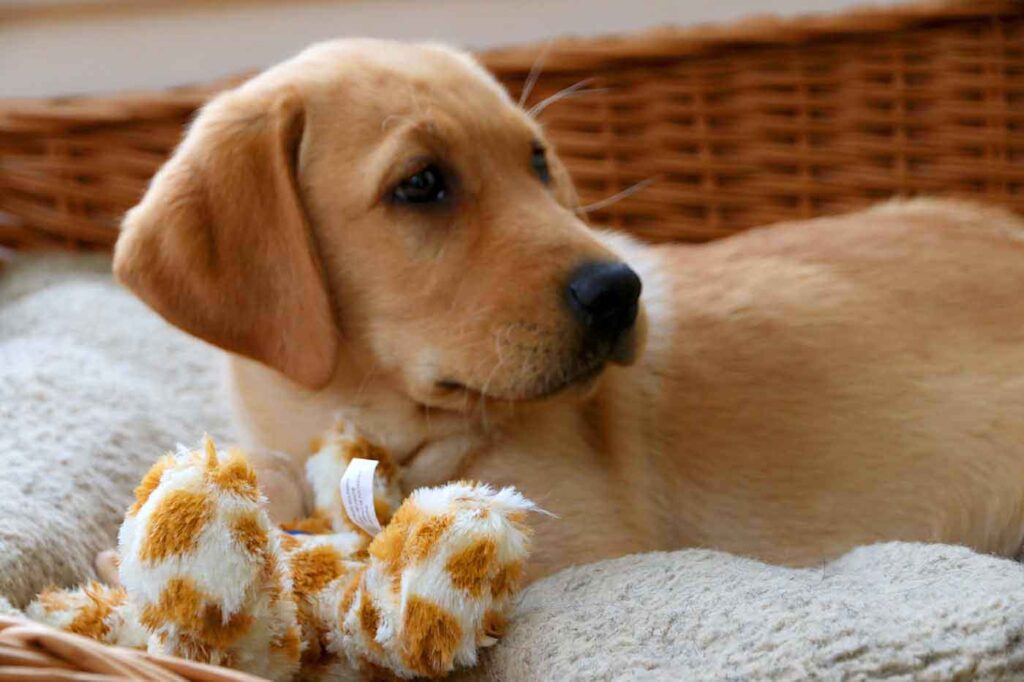
#4 Dogs That Chew When They Are Anxious
Very few of us can take our dogs everywhere, and we do need to leave them on their own from time to time. Ideally, all dogs need to learn to spend time alone from puppyhood onwards. A well-adjusted adult dog is then happy to be left from time to time, and will simply sleep when you are gone. This is especially true when they have a set routine and schedule.

However, some dogs are not happy left alone. There can be a few reasons for this:
• Dogs not taught to accept some periods of solitude in puppyhood,
• Dogs left alone for far too long,
• Dogs that have had traumatic experiences when left alone
Accordingly, these dogs may develop a disorder called separation anxiety. A dog that becomes very anxious when left may resort to destroying your possessions. Even worse, they may destroy the very fabric of your home as they try to relieve the anxiety. In a roundabout way, this brings us to the point that the act of chewing is in itself, very pleasurable and calming to many dogs. Some dogs just chew because it is great fun.
#5 Dogs Chewing For Relaxation And Pleasure
There is no doubt that many dogs simply chew for fun. They aren’t anxious, and they are not particularly bored. They just enjoy having a good long chew because it relaxes them and makes them feel happy. The problems arise, when they direct chewing activity at the wrong items: in other words, your items!
Relaxation chewing is particularly common in Labradors and other retrievers. Again, this is partly because we have bred them to enjoy having things in their mouths. Whatever the reason for dog chewing, it can become a deeply ingrained habit, which is more difficult to stop.
#6 Dogs That Chew From Habit
Like many other stress-busting or pleasurable activities, chewing can become a deeply ingrained habit. Think about people chewing their nails – it can be a very difficult habit to break. Habits can be difficult to change and breaking a habit may involve physically barring your dog from parts of your home. We’ll look at that in more detail below.
Before we get to that, we need to look at a few other potential causes of chewing. While the previous causes make up the vast majority of chewing cases, a few may be due to underlying medical problems.
Unusual Causes Of Dogs Chewing
Occasionally a dog will start chewing because he has some kind of medical problem. This is more likely to be the cause if the chewing starts quite suddenly in an older dog that never had a problem before.
As with any other unusual changes in your dog’s behavior, you should report a chewing habit that suddenly appears in a mature dog to your vet. They can rule out any physical problems that may be affecting your pet. As another question that crops up in the forums, do dogs chew because they are hungry?
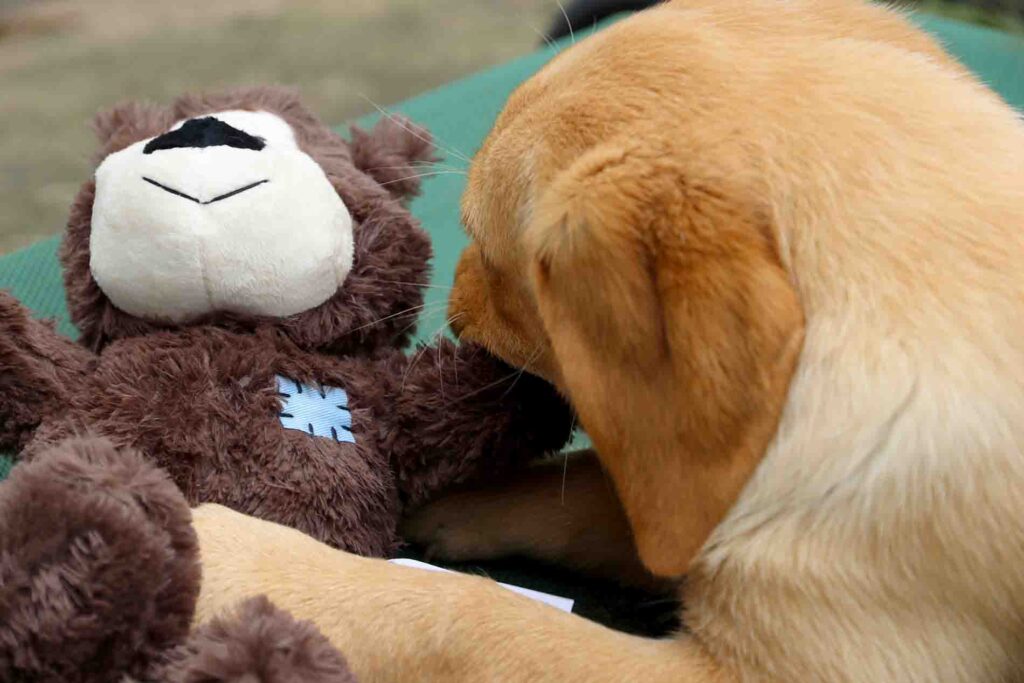
Do Dogs Chew From Hunger
Chewing isn’t usually related to hunger although, of course, a hungry dog may be bored or even stressed while waiting for his meal. That can certainly create the urge to chew. In any case, eating is a transient affair for most Labradors, so you can never hope to prevent chewing by giving your dog something to eat. The food disappears in a moment and doesn’t satisfy the urge to chew. The other problem is that she’ll soon be as fat as a barrel!
Now, we looked at all kinds of reasons for chewing, so we can make a plan to improve things. First, let’s look at the role that punishment or corrections have to play. When you see your house and possessions trashed, punishment is often the first thing that springs to mind.
Can I Stop Dog Chewing With Punishment?
There are a number of problems with punishment in general, but punishment for chewing is especially problematic. Punishment can be very counterproductive and actually encourage the behavior. When you punish your dog, even mildly, this focuses a lot of attention on the dog. Counter-intuitively, this can make things worse, especially with a dog that is bored and/or craves more of your attention.
Many Labradors are attention seekers because we bred them to work closely with their human partners. As a result, they love to be with humans and crave the attention. It’s their happy place and fulfils what they are designed to do. If your dog feels rewarded by your attention, even though you are angry with him, it won’t stop him wrecking your stuff in the future. Instead, it will make him more secretive about it, or it can even make him do it more because he knows you will respond
Although punishment can create problems, that does not mean that you should never punish your dog for it.
How To Punish A Dog For Chewing?
This is a popular question because some people believe that, because punishment can be counterproductive, you should never punish a dog for chewing. This is correct when dogs chew because they are lonely and anxious. Most destructive chewing in older dogs goes on behind your back or when you are away from home.
The problem is, when you punish a dog, he does not know what he is in trouble for.
In this case, punishment isn’t about stopping a behavior – it is about vengeance, which has no effect.
Catching Them In The Act
If you catch a dog in the act, then chastising her can work and stop her from doing it. In other words, punishment can sometimes be a way to teach your dog not to chew things in front of you. However, it is nigh on impossible to teach a dog not to chew things in your absence.
Short of setting up a video, monitoring it around the clock, and operating some kind of remote punishment device in your kitchen, it can’t be done. This goes for punishment in general, not just for chewing. Punishing the dog ‘at the scene of the crime’ so to speak, has been proven to be ineffective if there is any kind of time delay.
Punishment only works if it occurs during the bad behavior. So, it won’t work if you punish your dog when you get home for chewing up the sofa cushions while you were out. He’ll just think you are grumpy and unreasonable.
Effectively, all that punishment does is teach your dog to be more sneaky about chewing. So, it’s best you don’t consider it at all, unless you want to change the dynamic and have a dog who is frightened of you rather than a friend.
Staying Friends With Your Puppy
Apart from anything else, punishing a puppy will not prevent him chewing. Sometimes, she needs to chew, and chewing is completely normal and natural for her. What punishment will do is make your puppy afraid of you. With that, you are storing up problems for later life and it becomes very counterproductive.
So, let’s look at practical ways to stop your Labrador chewing things you don’t want him to chew. We’ll start with those teething puppies.
How To Stop A Puppy From Chewing
A major cause of puppy chewing is teething. You can’t do anything about it and it’s a process your puppy must pass through. Because puppies are inevitably going to chew, and actually need to chew, your main strategy is a two pronged approach
- Prevent access to your valuable possessions
- Redirect chewing to appropriate toys
Preventing access means restricting puppies to rooms where there are no valuable possessions lying around. Or, clear valuable possessions out of a puppy’s reach throughout the home. Restricting the puppy’s access is the easier option unless you are a very tidy family indeed!
The best way to stop a dog chewing valuable possessions is to restrict access with a dog gate or baby gate(paid link)*. That’s chewing related to teething solved, so what about other causes of chewing? With older dogs, who are past the seven month teething cut off point, we need a more comprehensive plan.
How To Stop A Dog From Chewing – Action Steps
There are three parts to our plan, which proves effective for the majority of chewing behaviors. It takes time, patience and, most of all, consistency. Make sure that the entire family buys into the plan. For example, I told my kids that, if they left anything lying around in the dog’s area and the dog destroyed it, they would pay for it out of their allowance! Here’s the three steps:
- Remove causes
- Redirect the chewing
- Break the habit
The first step is to make sure you have removed the causes of chewing.
#1 Remove The Causes Of Chewing
Labradors need plenty of exercise and some company. In many homes, everyone is out at work all day, and young dogs can get very bored when left alone for long periods.
Try to give your dog a good long walk before you leave for work, and arrange for someone to come in and take him for another walk part way through the day. She is more likely to relax and sleep rather instead of dismantling your sofa cushions if she has had enough exercise. If your day is a very long one, consider sending him to doggy day care, where he will enjoy the company of other dogs while you are at work.
Combining a dog with full time work can be challenging and you may need some extra help. You’ll find lots of information in that link ,and you can get support from other working dogs parents in our forum. Many of our regular posters understand the issues of separation anxiety very well.
Preventing Separation Anxiety
If your older dog has a separation anxiety issues, consider a consultation with a dog behaviorist. They will be able to assess your dog in his home environment and give you a plan to help.
If you have a young puppy, you can help them to avoid developing separation anxiety. You can teach your puppy to cope with being alone for short periods of time from an early age. Check out my click for quiet article for more information on helping puppies that cry when you leave them. Don’t forget to keep separations very short to begin with.
Make sure that puppies left alone for more than a minute or two have something appropriate to occupy them. Rescue dogs may need similar treatment, and you can introduce them to separation gradually when you first bring them home.
Now, what about chewing for pleasure? This is a different type of behavior that you don’t want to discourage. Chewing can help a dog’s teeth remain strong and healthy, and it can also help them mentally.
#2 Redirect The Chewing Onto Appropriate Toys
Once you have tackled the causes of destructive chewing, you need to tackle your dog’s natural need to chew for pleasure. This means redirecting his chewing activities onto sensible alternatives. This isn’t always as straightforward as it might seem.
Chewing For Pleasure
Chewing for pleasure is one cause of chewing you cannot and should not try to remove or prevent in your dog. What we do with dogs that like to chew for pleasure, and that includes all puppies, is redirect their chewing onto something more appropriate than your favorite shoes. However, most people give their dogs chew toys and then wonder why he prefers to gnaw on the table legs. The fact is, most chew toys are rather boring.
How do we keep playing and chewing interesting, and save your long-suffering furniture from harm?
Some puppies enjoy those giant knotted rope toys, though they are not indestructible. You’ll need to keep an eye on them and remove them when they start to come apart. A few other toys and distractions can work well.
How To Stop A Dog From Chewing – The Ideal Chew Toy
To make chew toys really appealing, you usually need to add something interesting. For most Labradors, that means food! Dipping chew toys in savory spreads like yeast extract or peanut butter can help extend the pleasure time, but not for long. The odd dog chew, such as the rawhide ones that last for hours, are useful although don’t overdo it because you don’t want a fat dog. However, in my experience, even long-lasting chews can become boring after a while.
The answer lies in the wonderful Kong toy(paid link)*. In fact what you need is not one, but several Kongs. Toys, like the Kong, that contain food but make the dog work to get at it, are a useful distraction that can also stop doggy boredom.
Why Kongs Help Stop Labradors Chewing Your Things
The kong is a hollow, tough, rubber toy that most dogs cannot destroy. The Kong Extreme*(paid link) is especially sturdy and great for very aggressive chewers. The important part, however, of a Kong’s structure is the hollow in the middle. Your job is to fill this hollow centre with something delicious and then, as the most important part, freeze it solid.
When you leave your puppy or young dog alone or unsupervised for long – give him a frozen Kong first. This will keep him happy for quite some time.
Choosing The Right Kong
You can get Kongs in puppy sizes for little ones and in black extra strong rubber for really strong chewers. The red ones are suitable for most adult Labs*(paid link).

You’ll need several so that there is always one ready in the freezer while you wash and refill the others. Kongs are not the cheapest toy, but they are an indispensable aid to preventing destructive chewing in the long term. Quite simply, don’t leave home without giving one to your dog. This is especially important with dogs that have an existing chewing habit or suffer from boredom or anxiety.
Think of it this way: if you have to sit in a waiting time for a long time before you see a doctor, it is boring if you don’t have a book, smartphone, or some other distraction. It’s the same for your furry friend. In a way, a Kong is an iPad for dogs! So, now you have tackled your dog’s boredom and any anxiety issues, and you have an alternative system for redirecting his chewing onto his frozen Kong toys, what’s next?
#3 Avoid Or Break Bad Habits
The final step in the plan is to break any existing bad chewing habits. In young puppies, you want to prevent those habits developing in the first place. In both cases, this is a physical issue. When it comes to avoiding or breaking bad habits, you need to physically prevent the puppy from indulging in them.
Some people struggle with this. They are hoping for a magic command or cue to give their dog that will prevent chewing in their absence. Sadly, this isn’t going to happen. Let’s give you some examples of different problems that can be addressed this way
How To Stop A Dog From Chewing Shoes
Chewing shoes is a very common problem. Dogs like the smell of feet and Labs love to carry shoes around, looking very pleased with themselves. One thing you can do is teach your Lab to bring your shoes to you and hand them over, rather than running off with them. However, in the meantime, to break the habit of chewing shoes, I’m afraid the answer involves a little effort on your part
You are going to need to get everyone in the family to put their shoes away for a while, at least until your dog has passed through the chewing phase.
We invested in a shoe rack for our front and back porches and taught everyone to leave their shoes there rather than in the hall or on their bedroom floors. The dogs don’t have access to these areas. If your bedrooms are upstairs you can insist the family puts their shoes in their rooms. You can then place a dog gate across the bottom of the stairs so your pooch has no access. This kind of strategy is especially important with puppies.
Leaving Everything Out Of Reach
It’s just a matter of developing good habits. Before we adopt our first dog, most of us are used to being able to put things down on the floor or low tables. They will still be there when we come back. Life with a puppy isn’t quite like that. If you leave the TV remote on the chair, your puppy will pick it up. She’ll run around with it for a bit, feeling it is the best toy in the entire world. When she’s done with running, she’ll lie down and chew it up. That’s what puppies do.
If you’re trying to deal with this behavior one incident at a time, it’s exhausting! You’ll soon fall out with your puppy in a big way. So, we’ll repeat: the best way to save your possessions is to prevent your puppy having access to rooms with important items in them. You should remind the family to pick up stuff in rooms where puppies have free access. Now, what about furniture? You can’t exactly put your sofa in the bedroom until the puppy grows!
How To Stop A Dog From Chewing Furniture
Obviously, you can’t put your sofa or favorite lamp away, so let’s look at how you can protect things that cannot be moved. One solution is to block access to that particular room except under supervision. Again, a dog gate or baby gate works well. If you have an open plan home, you can buy extended systems that can literally divide an entire room Another solution is to try some kind of spray on dog chewing deterrent
Using A Stop Dog Chewing Spray
You can buy spray on repellents that will deter some puppies and dogs from chewing. These are intended to deter dogs because of the odor. You can try spraying it on your table legs and see if it works.
Pro Anti-Chew Spray*(paid link) is a popular brand. It is alcohol free and you can even spray it on your furniture and clothes.

It’s probably a good idea to test a little bit where it doesn’t show in case it affects the color, but it shouldn’t do.
Make sure you buy a spray intended for furniture rather than for spraying on dogs that are nibbling themselves. That’s a really easy mistake to make – I have been there! The reviews for all dog chewing deterrent sprays tend to be mixed – you’ll need to try it to find out whether it will have a strong repellent effect on your dog. They can be effective, but there are no guarantees.
How To Stop A Dog Chewing Wood Baseboards And Doors
As with chewing furniture, if your doggy can’t resist chewing baseboards and doors, exclusion and sprays are the two main options to try. When a dog does chew walls or the framework of your home, it’s especially important to remember that this kind of behavior, especially in adult dogs, is often associated with isolation or anxiety.
Think hard about providing your dog with more company or mental stimulation as well as breaking the chewing habit with barriers or sprays. Bear in mind that some puppies and dogs seem indifferent to the taste of the spray and will happily carry on chewing wood even when it you coat it liberally in unpleasant substances! I would swear that one of my dogs chewed things even more! Accordingly, in many cases, dog gates are the best option if a dog chews everything.
Dog Gates For Determined Chewers
You don’t need to buy a dog gate specifically designed for dogs if you have a Labrador puppy. Baby gates are fine. To keep puppies away from your more precious possessions and soft furnishings, at a minimum, you’re going to need some baby gates like this one*(paid link).

Put these across doorways or anywhere you don’t want the puppy to go, such as making your upstairs out of bounds, for example. For older dogs, you can get taller baby gates that even a Labrador can’t jump. You can buy extending baby gates for large openings*(paid link) in open plan homes.

Crating Your Puppy
Many people use a crate to keep their puppy out of mischief*(paid link) at night and when they leave the house.

If you are going to crate your puppy, you need to do so for very short periods of time and leave the enough puppy suitable chew toys to occupy his need to chew while you are gone.
If you are going to go out for longer periods, then you’ll need to get someone to care for your puppy. Alternately, you can use a puppy playpen or puppy proof room instead of a crate, although this won’t prevent separation anxiety. We’ve talked about protecting your home from canine destruction, but your vehicle can be at risk, too!
Don’t Forget Your Vehicle!
Crates are also really useful in vehicles and can save you from a lot of heart ache. One small dog can run up a very large bill when left alone in the interior of a car for a few minutes. Many years ago, my young Labrador ate through both the passenger and driver safety belts in our Landrover when we left him alone for less than twenty minutes. That was a very expensive lesson for us as a young hard-up couple.
You can buy safety harnesses for young dog to sit on the back seat*(paid link) of your vehicle. Sadly, these harnesses and the interior of your car are vulnerable to the attentions of your Labrador’s teeth.

Using a crate in the vehicle is often a better solution, at least until your Labrador has got past the chewing stage. Check out our Travel Crates For Labradors section for detailed reviews. One problem that often crops up is puppies destroying their own bedding.
What About Puppy Bedding?
People often ask me what they can do about their puppy chewing up his own bed. This is a tricky one. None of us wants to see a puppy without a bed, but if your puppy is tearing lumps off his and swallowing them, you are going to need to remove it for a while.
A firm mat*(paid link), or some vet bed*(paid link) is often the best option for bed chewers, but you’ll need to watch and supervise to make sure your puppy isn’t swallowing that too.

When The Chewing Finally Stops
At some point, most dogs, even Labradors, grow out of constant chewing. At this point, having broken the bad habit or successfully prevented one from starting, you’ll be able to give your dog the freedom of the house. You can heave a sigh of relief and put away your gates and your bitter spray.
If you are thinking about putting away your puppy crate, be aware that it is very tempting to de-crate big dogs too soon. This is because large dogs need large crates, and these crates are an unsightly nuisance in all but the biggest houses. Accordingly, some owners can’t wait to take them away and store them in the garage.
Don’t forget that many Labradors will carry on chewing things they shouldn’t until well past their first birthday. Some will continue until they are around two years old. So, a little patience is required. Remember to be very generous with those frozen Kongs during the de-crating process, and for the next few months. If your dog hasn’t started a chewing habit by then, he probably never will.
Affiliate link disclosure: Links in this article marked with an * are affiliate links, and we may receive a small commission if you purchase these products. However, we selected them for inclusion independently, and all of the views expressed in this article are our own.

Free Labrador Updates!
Get my training tips, news, reviews, and the latest from The Labrador Site delivered to your inbox

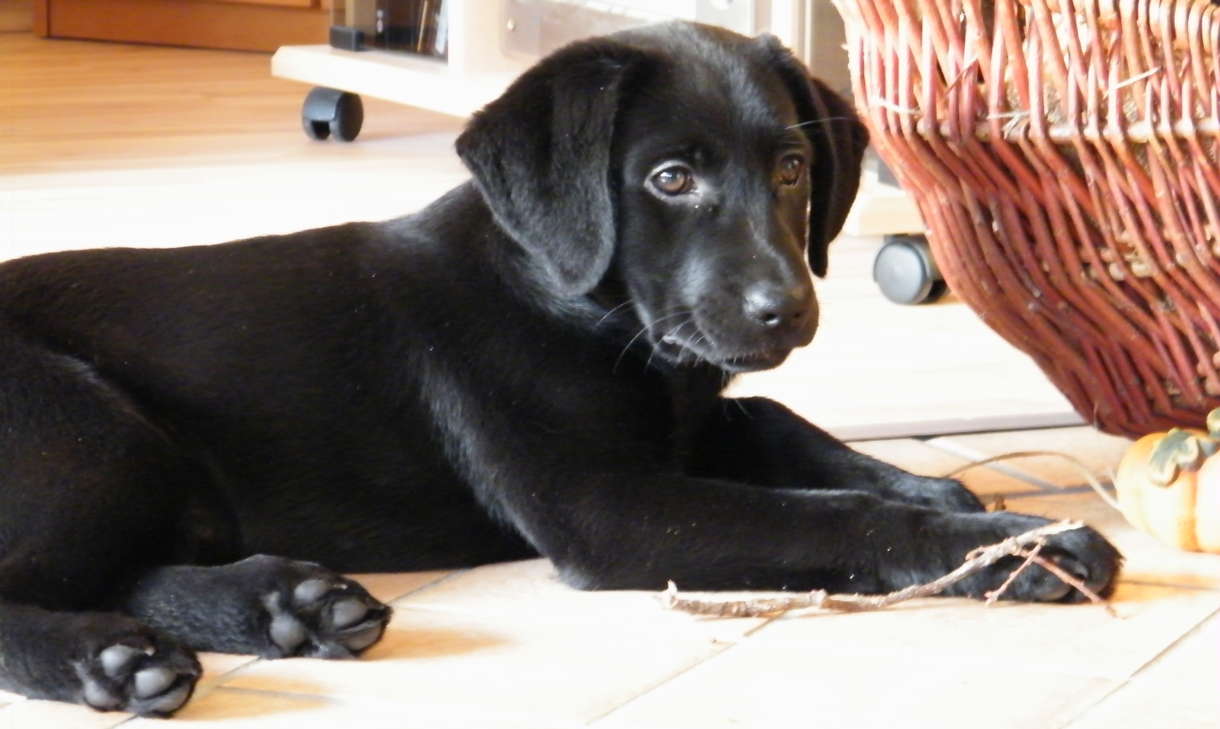
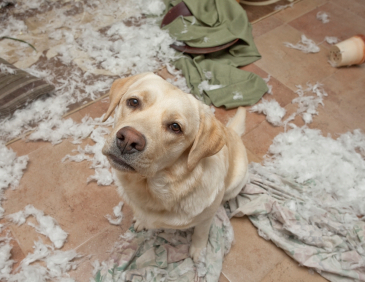
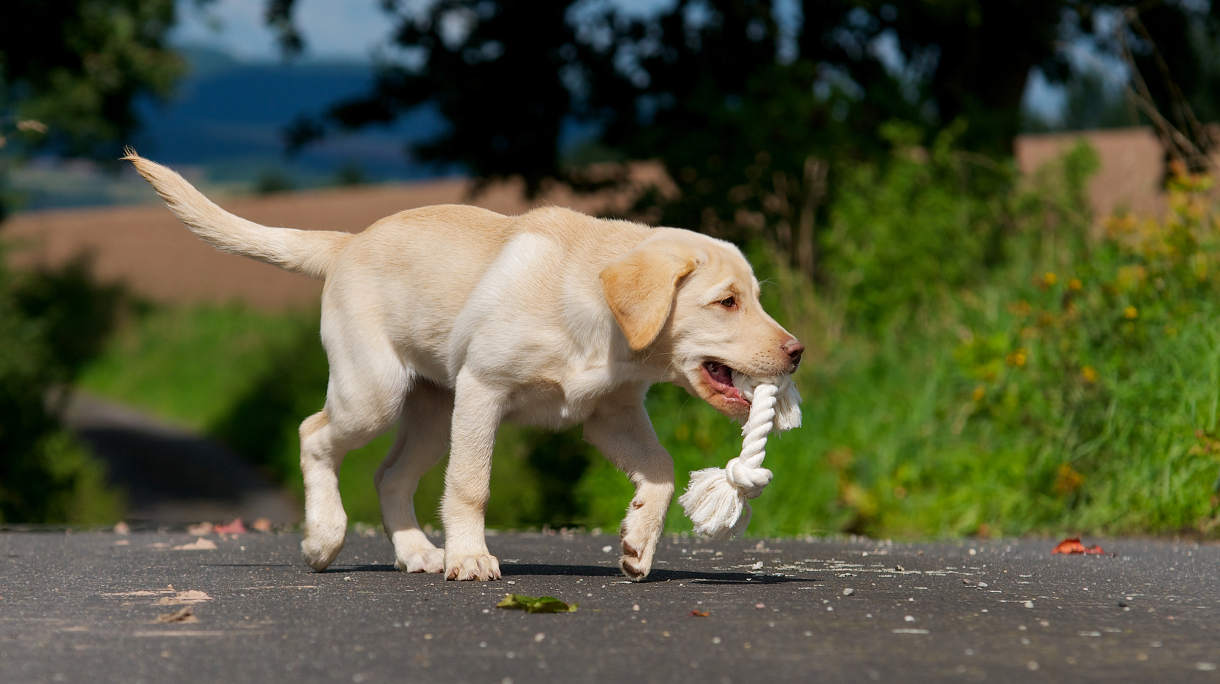


I love my 13 month old yellow lab. But she’s a weapon of mass destruction. There is absolutely nothing in the house that she hasn’t ripped apart or chewed up. I’ve tried everything! Help!
Hi Manna, Sorry to hear you are struggling with your dog’s chewing. If you have gone through every idea in this guide and the problem isn’t resolved, the next step would be to get a professional behaviorist in to see where things could be improved. Ask your local veterinarian to recommend someone in the area who uses positive reinforcement methods. Best of luck!
I thought that if you fill a Kong with food thus blocking the air hole, it could create a suction on their tongue when the dog is trying to get the food and they not be able to get their tongue out of the Kong cutting off circulation to the tongue. That it mite create a suction? This would be very awful and sad if it were to happen because someone stuffed it full of peanut butter or frozen foods.
Ann
Very interesting article…many thanks …
Trampoline, Roller blind doors, wooden doors, outdoor furniture and cushions, several shoes, dog beds, plants, toys…. 18 months and still going strong.
By 4 months of age our yellow lab has destroyed 4 kitchen chairs, the legs to the table, and a tablecloth, as well as completely knawed through the wooden baby gate used to pen him in the kitchen. A pair of steel-toed work boots, 2 doggy beds, and my reading glasses.
We have a six month old black lab we love to pieces…..pieces is the key word. He has eaten the bottom of our love seat, couch, torn up our french doors and pulled all the weather stripping off the door. Eaten my photo albums, eaten 3 bags of candy corn resulting in a call to the vet. and eaten new business furniture still in the box. Wherever he lays he chews……he is a chewing machine. We dont crate but pray for the day he quits chewing.
My lab eats Kong’s.
Not the indestructible toy everyone believes. I find red rubber pieces everywhere, even in his stool.
We adopted a 4 month old chocolate lab from the pound. He was great at first but it wasn’t long before he started chewing things. We tried crating him and he literally bent the metal bars and got out. We tried baby gates and he pulled on the door with his teeth until he got the door open. We tried an outdoor kennel for when we would leave him and he found a way out of that also. So, we just took another chance. He eventually began to chew furniture and a few sentimental things in the house. He completely destroyed two recliner chairs and pulled curtains down. We ended up resorting to anxiety meds from the vet. We never left him over 3 or 4 hours at a time but he just can not handle the separation. End of story…we still love him! ♡
I agree with Venessa. I like your article but the one thing that I must disagree is that our labrador absolutely knows when he’s done something bad, like chew something up, even hours later because the minute I pick up the torn item, he heads for the hills. I’m just wondering if putting them in an isolated room after each time they chew something doesn’t at some point help them correlate not being with their family when they chew things?
I just looked outside… It’s a warm day, and my 14 month old lab has two other dogs and lots of backyard toys to play with. He is eating the siding off our house! My husband is going to go ballistic! Not sure what to do. He also ate the bottom of two or three fence pockets, allowing our little dogs to get out.
I have an almost 14 month young female lab/retriever mix. We had to leave her “Alone” (we have another, 13 year old female dog who never chewed up anything but a sock and 1 shoe!). I had my assistant coming after being away for 4 hrs, to walk her. I had confined my youngster into the kitchen, so she couldn’t get into any kids toys and such. She scratched a whole into the kitchen mat, and tore apart one of her 2 dog beds. A week later (Today!), I left her for 6 hrs. this time, I put her in the back yard with my other dog, and a friends dog. I left the door to the patio open, so they could go inside. Not much Annie could get into there. So I thought. Once back at home, the back yard looked like a war zone. 2 window screens were scratched through. 2 holes dug into the ground.an entire role of paper towels torn apart (not shredded, but actually ripped neatly off at the tear-line). One sneaker that was left out accidentaly got its inlet taken out and torn apart. The worst: she got into 3 big containers of protein shakes, took them outside, managed to open them, and than ate/licked one completely clean, and strew the other 2 across the yard. She easily occurred a damage of $400.00. She knew what she did was wrong,b/c she acted all ashamed. I don’t want to crate her, especially for more than 4 hrs. I’m typically 24/7 with her, she goes to work with me (I run a dog exercise business), so she gets a ton of exercise, but left alone, especially longer stretches, are impossible. Even 10 minutes, if not confined, will be used to get into shenanigans. I don’t know if it’s anxiety, or boredom. Or a mixture of both? She was left alone for the majority of the day, or even longer, in the back yard as a puppy, with little to no exercise. I adopted her when she was 10 months young. Could she still be damaged from that time?
Dogs don’t feel ashamed. They just react to your anger and try to appease you. Dogs that are super destructive should be crated when unsupervised.
My dog expect loves the petstages stuffingless alligator squeaky toy. They have lasted the longest. I’ve had 3 the past year and just got 2 more for Christmas. He’s not interested in the food filled Kong after the food is gone!